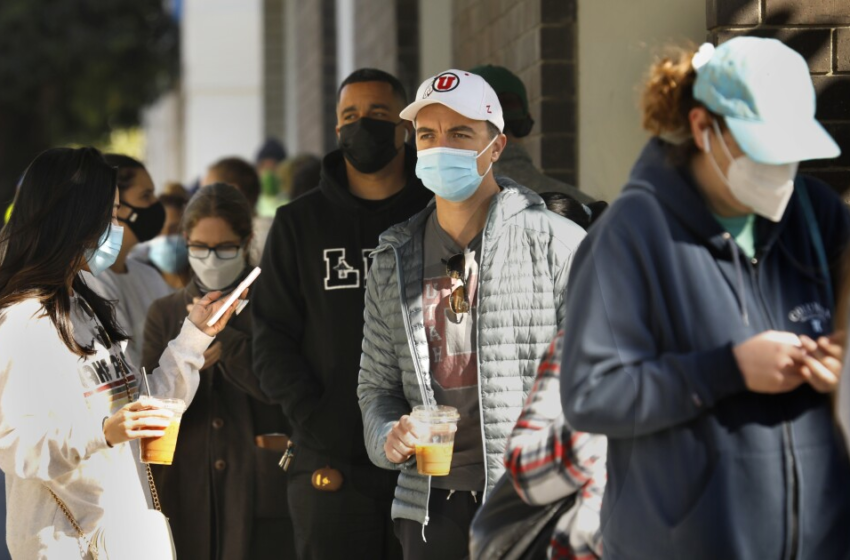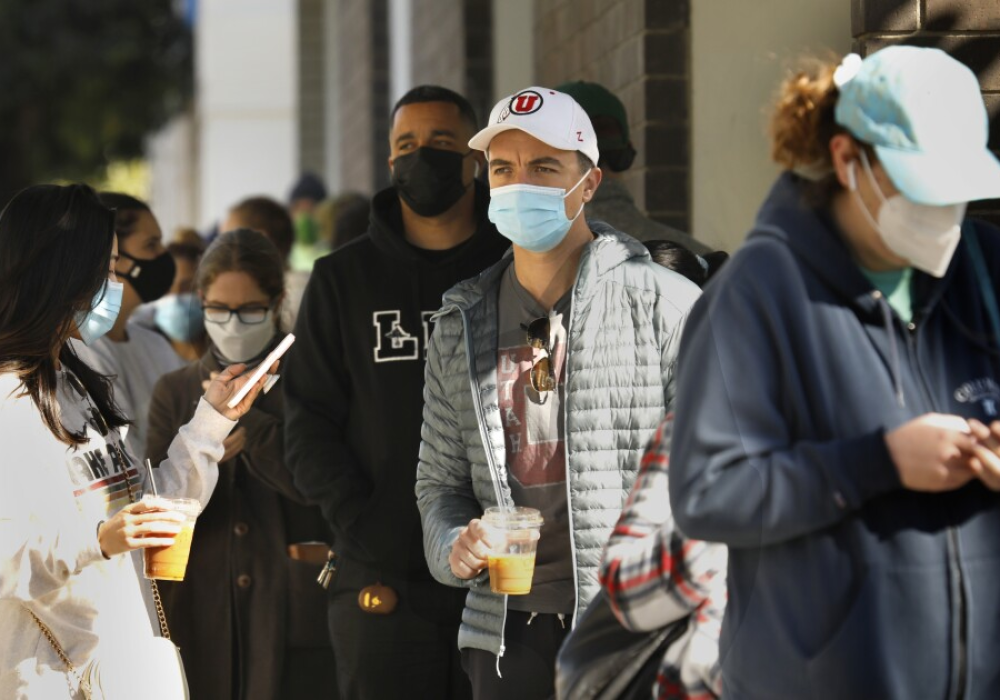Coronavirus cases in California exploded into record territory as counts from the holiday weekend were tallied, and officials are warning that the next few weeks are crucial in the fight against the highly infectious Omicron variant.
The mounting toll was evident in long lines for those seeking tests and increasingly crowded conditions at some hospitals. In a sign of how widespread the coronavirus is, the share of tests coming back positive reached a seven-day rate of 20.4%, the highest during the pandemic so far, according to the California Department of Public Health.
“We need to quickly adapt to periods of high transmission, like right now,” San Francisco Health Director Dr. Grant Colfax said in a statement Tuesday. “The next several weeks are absolutely critical. It is within our power to limit the damage of this latest surge, but we need everybody’s help.”
The state reported a massive backlog of 237,084 new cases Tuesday, a total that includes four days’ worth of data. This pushed the statewide seven-day average of newly announced infections to 50,267, easily eclipsing the sky-high case counts seen during last winter’s deadly COVID-19 wave, according to data compiled by The Times.
The degree to which the holiday reporting delay has warped the weekly case average won’t become clear until New Year’s is further in the rearview mirror.
However, it’s already apparent that California is experiencing a record-smashing surge.
According to slower-to-update figures that track infections by the date someone begins experiencing symptoms, an average of 45,466 Californians per day were falling ill during the week leading up to Dec. 31. Data for more recent days are still incomplete.
That figure outstrips the previous pandemic peak of 45,059 new daily infections, which was recorded over the weeklong period ending Jan. 8, 2021.
While the higher recently reported case number is affected by the backlog, it also likely fails to capture many of those who are testing positive using self-administered at-home tests — meaning not every new coronavirus-positive Californian necessarily shows up in the state database.
Regardless, it’s clear that COVID-19 has rebounded with a vengeance in the Golden State.
Los Angeles County reported 21,790 new positive cases Tuesday — the fourth time in the last five days that the county’s daily caseload has topped 20,000.
With the coronavirus this omnipresent, health officials say it’s vital for residents to take steps to protect themselves. Those include avoiding crowded situations, wearing high-quality masks while in indoor public settings and getting vaccinated and boosted when eligible.
“Choosing not to take the vaccine during this explosive winter surge is very risky, since so many of those ill with COVID in the intensive care units at hospitals are unvaccinated, and tragically, some of these individuals will not survive,” county Public Health Director Barbara Ferrer said. “So as we start this new year, please protect yourselves by getting vaccinated and boosted if eligible, and give others around you the peace of mind that comes from reducing the risk of a terrible outcome as more and more people are infected with this virus.”
Already, a deluge of new coronavirus-positive people has hit California’s hospitals. The number of patients has more than doubled over the past two weeks, reaching 7,405 Monday.
That figure remains well short of the nearly 22,000 coronavirus-positive patients who were hospitalized on some days during last winter’s wave. But the rapid rise has raised alarms that a renewed crush of patients could still strain hospitals — especially in areas with lower vaccination rates.
So far, the number of Californians dying from COVID-19 has not followed the trendlines of other metrics. Over the last week, an average of 52 people per day have died from COVID-19, a decrease of 21% from two weeks ago.
Officials caution, however, that it can take weeks for spikes in coronavirus transmission to trigger increases in both fatalities and hospitalizations.
But during the recent surge, California COVID-19 hospitalizations have not risen as fast as coronavirus cases.
That disconnect could be a result of Omicron causing less-severe symptoms, on average, than the Delta variant, although it has been hard to ascertain whether the recent spike in hospitalizations is primarily the work of Omicron or Delta.
At Kaiser Permanente Southern California, 94% of COVID samples that were tested as of this week were the Omicron variant, with Delta making up the remaining 6%, according to regional medical director for quality Dr. Nancy Gin.
Along with burgeoning patient counts, there are also concerns that the coronavirus may force desperately needed healthcare workers off the front lines.
In Los Angeles County, health officials said this week they’re beginning to see delays in ambulance response to 911 calls as more employees are unable to work because of COVID-related illnesses and ambulances are forced to wait to offload patients at hospitals.
According to the latest figures from the state Department of Public Health, unvaccinated Californians are 14.5 times more likely to be hospitalized with COVID-19 and 15 times more likely to die from the disease than their fully vaccinated counterparts.
The “unvaccinated are taking up hospital beds and crowding emergency rooms and intensive care units. That’s displacing other people who need access to those hospitals,” President Biden said during a briefing Tuesday.
“We have in hand all the vaccines we need to get every American fully vaccinated, including the booster shot,” he added. “So there’s no excuse — no excuse — for anyone being unvaccinated. This continues to be a pandemic of the unvaccinated.”
There are also some indications of a gulf between the number of people in hospitals who have tested positive for the coronavirus compared with those admitted with the disease.
Roughly two-thirds of patients who have tested positive at hospitals run by the L.A. County Department of Health Services were admitted for something other than the coronavirus, Health Services Director Dr. Christina Ghaly said Monday.
During last winter’s surge, more than 80% of COVID-19 patients were in the hospital because they were experiencing severe illness associated with the disease.
“The difference we are seeing this year is largely due to the fact that we have a higher number of individuals who have been vaccinated and boosted,” department officials wrote in a statement to The Times.
Times staff writer Emily Alpert Reyes contributed to this report.










